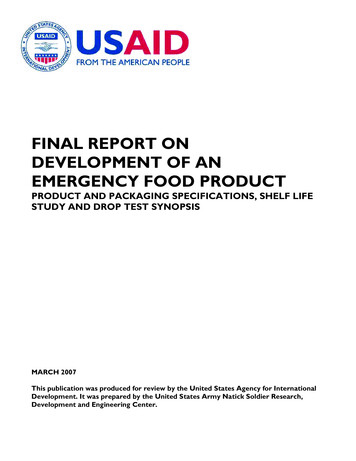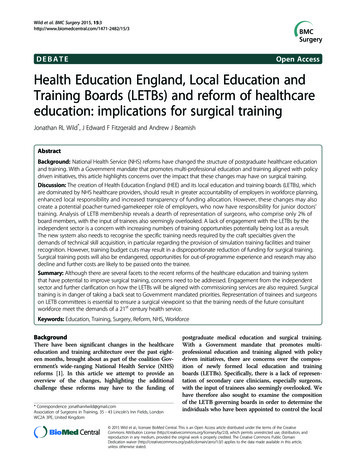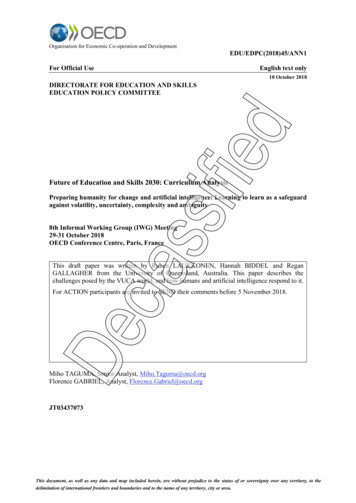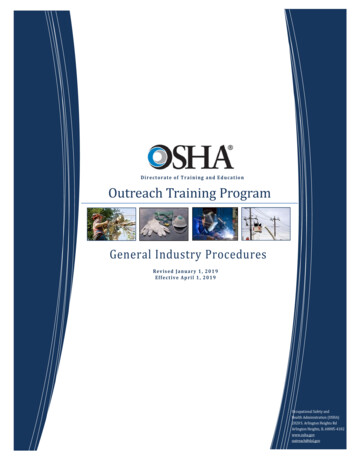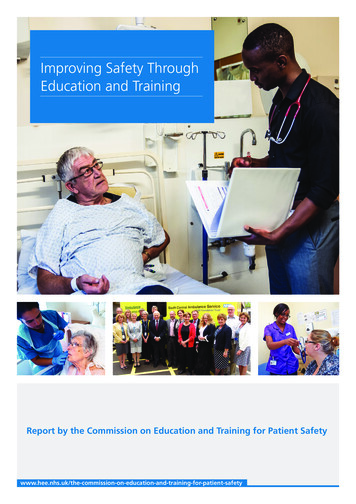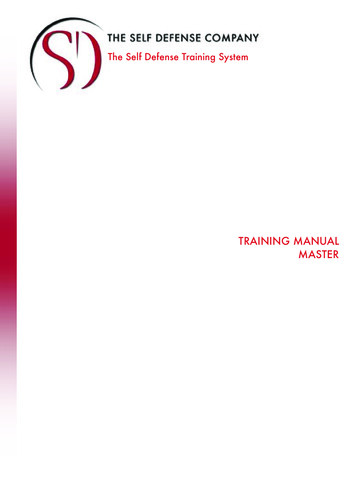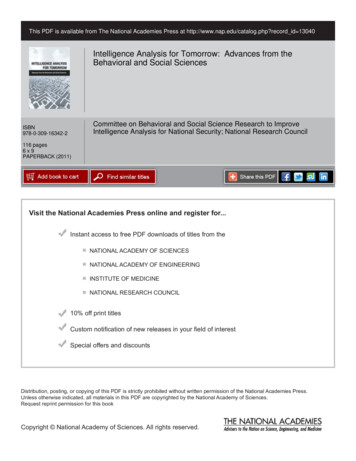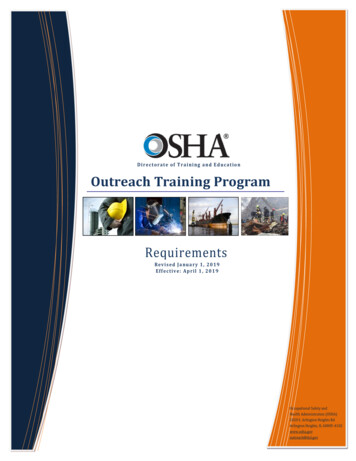
Transcription
Di r e c t o r a t e o f T r a i n i ng a n d E d u ca t i o nOutreach Training ProgramRequirementsRevised January 1, 2019E f f e c t i v e: A p r i l 1 , 2 0 1 9Occupational Safety andHealth Administration (OSHA)2020 S. Arlington Heights RdArlington Heights, IL 60005-4102www.osha.govoutreach@dol.gov
[PAGE INTENTIONALLY LEFT BLANK]
Table of ContentsRecord of Changes . iiiI. Trainer Requirements. .1A. OSHA Outreach Training Program Requirements. .1B. OSHA Outreach Training Program Procedures. .1C. OSHA Outreach Training Program Investigation and Review Procedures .1II. OSHA Outreach Training Program Overview .1III. Authorized OSHA Outreach Training Program Trainer Designation .1A. Becoming an OSHA Outreach Training Program Trainer.1B. Update Requirement .2C. Trainer Update Exemption for Overseas Military Service.2D. Course Offerings .2IV. OSHA Outreach Training Program Contacts .2A. Authorizing Training Organization.2B. OSHA Directorate of Training and Education .3V. OSHA Outreach Training Program Requirements .3A. OSHA Outreach Training Program Trainer Responsibilities .3B. Statement of Compliance .4C. Exception Requests .5D. Investigation and Review Procedures .5E. Trainer Code of Conduct .5F. Training Delivery.6G. Makeup Training .10H. Training Topics .10I. Training Materials .11J. Topic Length .12K. Geographic Limitations.12L. Training Language.14M. Types of OSHA Outreach Training Program Trainers .14N. Minimum Class Size .15O. Maximum Class Size .16P. Records Retention.16Q. Advertising .18R. Alternative Training Methods .19VI. Industry Sector-Specific Emphasis Training .21VII. How to Obtain Student Course Completion Cards .22A. Trainer ID Number.22i
B. Submit Required Class Documentation .22C. Key Points on Submitting Class Documentation .24D. Where to Send Class Documentation.24E. Lost, Damaged, Misprinted, or Erroneous Cards .25VIII. Student Course Completion Cards and Certificates .26A. Distribution of Student Course Completion Cards .26B. Receipt of Student Course Completion Cards.27C. Student Course Completion Card Fees. .27D. Card Completion .27E. Class Certificates .28IX. OSHA Outreach Training Program Monitoring .28A. Advance Notice of Training.29B. Training Observations .29C. Record Audits.29X. OSHA Outreach Training Program Trainer Watch List .29Appendix A – Statement of Compliance .30Appendix B – Training Resources .31ii
Record of ChangesThe following summary lists the substantive changes made to this document. Additional minorcontent, grammatical, or typographical corrections are included in this document. All OSHAauthorized Outreach trainers, Authorizing Training Organizations and other stakeholders mustcarefully review and adhere to OSHA Outreach Training Program requirements, procedures andrelated V.F.8.a.ChangeDeleted – There is no longer a grace period for trainers if their card hasexpired.Added – If a trainer’s authorization has expired, the trainer will be unableto conduct OSHA Outreach Training Program training and receive studentcourse completion cards.Revised – Extension to the trainer’s expiration date will not be granted,except as described in paragraph III.C below.Expanded – Serving or allowing alcohol to be served at, during, or inconjunction with, training activities.Revised – Discriminatory or defamatory remarks towards or regardingOSHA, an ATO, or any individual or group of individuals.Expanded – Trainers (primary, assistant, or guest) are not consideredstudents.Reordered paragraph(s) for clarity and added:Outreach Courses and Classes. OSHA defines a “course” as a series orlessons addressing specified topics to teach hazard awareness meeting therequired student contact hours. OSHA defines a “class” as an offering of a10- or 30-hour Outreach course within a specific timeframe that meets therequired minimum student contact hours. For example, a 10-hour Outreachconstruction class held between January 1 and 3, results in issuance of a10-hour Outreach construction course completion card.Reworded for clarity – The entire length of an individual training sessioncan be no more than 10 consecutive hours including 7.5 student contacthours, and administrative time such as lunch/meal and other breaks, takingattendance, and optional testing. For example, a training session can beconducted from 9:00 pm through 7:00 am the following day; however,cannot run past 7:00 am.Reordered paragraph(s) for clarity and deleted paragraph c:A 10 min break is required for every two (2) consecutive hours of training(including student contact hours and time spent on administrative mattersor tests), and a 30 minute lunch or meal break is required for every six (6)hours of training (including student contact hours and time spent onadministrative matters such as attendance or tests). Training is not allowedduring lunch or meals, or during other break periods.Revised – OSHA expects Outreach Training Program training to meetadult learning needs and include interactive activities. Therefore, trainingmust include workshops, case studies, exercises, and demonstrations thatiii
P. NoteV.Q.2.f.27VIII.A.2.31Appendix BChangeinvolve student participation and interaction.Added – “Instructor-led”Added – OSHA does not consider cost saving, trainer availability, programor workplace time limits, or missing work to be extenuating circumstances.Revised – The primary trainer’s printed first and last names andsignatures must also appear on the daily student sign-in sheets, attesting tothe accuracy of the data listed.Added - ” and facilitate processing of replacement card requests.”Added – Completion, submission, and retention .Added – Unobscured or fully legible depictions of student coursecompletion cards may not be posted on trainer or training organizationwebsites, or otherwise incorporated into advertising or marketingmaterials.Added – OSHA encourages, but does not require, trainers or trainingproviders to issue course completion cards through a trackable deliverymethod (e.g. USPS, UPS, FedEx, messenger service, etc.).Added – Note: The URLs provided below are subject to change. Trainingresources are accessible through the OSHA website at www.osha.gov.iv
I. Trainer Requirements. Requirements for trainers authorized through the Occupational Safetyand Health Administration (OSHA) Outreach Training Program (“Program”) are contained in thefollowing documents:A. OSHA Outreach Training Program Requirements. This document covers therequirements for OSHA Outreach Training Program authorized trainers in all OSHA OutreachTraining Programs.B. OSHA Outreach Training Program Procedures. These documents contain specificindustry program requirements (e.g. Construction, General Industry, Maritime, or Disaster SiteWorker).C. OSHA Outreach Training Program Investigation and Review Procedures. Theseprocedures are used by OSHA to process complaints or allegations of failure to comply withOSHA Outreach Training Program requirements. These procedures ensure programstandardization, due process for resolving problems, and support Program oversight.II. OSHA Outreach Training Program Overview. The purpose of the OSHA OutreachTraining Program is to teach workers about their rights, employer responsibilities, and how tofile a complaint as well as how to recognize, abate and prevent job-related hazards. OSHAauthorizes safety and health professionals who complete an OSHA Outreach Training Programtrainer course to conduct occupational safety and health classes for workers. After training iscompleted, trainers document the training to their Authorizing Training Organization (ATO) (seeSection IV.A.), and receive student course completion cards to distribute to the workers whomthey have trained. OSHA has promoted workplace safety and health by authorizing trainers since1971.The OSHA Outreach Training Program is voluntary. OSHA Outreach Training Program trainingdoes not meet the training requirements contained in any OSHA standard. Some states and localjurisdictions have enacted legislation mandating OSHA Outreach Training Program training, andsome employers and unions require workers to have this training to work on job sites or to fulfilltheir own safety training goals. However, the federal government does not mandate OSHAOutreach Training Program participation. For a complete list of OSHA’s training-relatedrequirements, see OSHA Publication #2254, Training Requirements in OSHA Standardsavailable through OSHA’s website (www.osha.gov).III. Authorized OSHA Outreach Training Program Trainer Designation.A. Becoming an OSHA Outreach Training Program Trainer. To become an OSHAOutreach Training Program trainer, an individual must meet the prerequisites and completethe applicable industry trainer course through an Authorizing Training Organization (ATO).See the specific industry program procedures for detailed information. Trainer courseprerequisites include components for both industry-specific safety and health experience andtraining in OSHA standards for that industry. These are separate components. Industryexperience cannot be used to fulfill or replace the training prerequisite component. OSHAdoes not waive the training prerequisite component.1
B. Update Requirement. To remain current on relevant OSHA matters and ensure qualitytraining, OSHA Outreach Training Program authorized trainers are required to complete atrainer update course every four (4) years. The trainer course may also be completed tomaintain a trainer’s authorized status.1. If a trainer’s authorization has expired, the trainer will be unable to conduct OSHAOutreach Training Program training and receive student course completion cards.2. Extensions to the trainer’s expiration date will not be granted, except as described inparagraph III.C below.C. Trainer Update Exemption for Overseas Military Service. Military membersreturning to the Continental United States (CONUS) from overseas assignment(s) have 90calendar days from their return date to renew their trainer authorization. Proof of militarystatus must be shown, including furnishing a copy of the military orders directing theservice member’s return to CONUS. Military reservists who serve more than 30 days onactive duty and then leave active duty status must furnish a copy of their DD-214.D. Course Offerings. Trainer and trainer update courses are offered through OSHATraining Institute (OTI) Education Centers. A searchable course schedule and a list ofcurrent OTI Education Centers can be found can be found through OSHA’s website(www.osha.gov).IV. OSHA Outreach Training Program ContactsA. Authorizing Training Organization. This refers to the organization that sponsored thetrainer’s most recent trainer course or trainer update course. The Authorizing TrainingOrganization (ATO) is either the OSHA Training Institute (OTI) or an OTI EducationCenter.1. The ATO is the trainer’s primary point of contact. The name of each trainer’s ATO isindicated either on the front of the OSHA Outreach Training Program authorized trainercard, below “OSHA, U.S. Department of Labor” or listed on the upper left portion on theback of the OSHA Outreach Training Program authorized trainer card, along with theATO contact information. This organization is responsible for answering trainerquestions, processing the OSHA Outreach Training Program Report (OTPR), and willissue student course completion cards. An ATO point-of-contact list is available onOSHA’s website (www.osha.gov).2. Trainers may be affiliated with only one Authorizing Training Organization perindustry. For example, a trainer may be authorized through one ATO for Construction,and authorized through a different ATO for General Industry. The trainer may not beauthorized as a Construction trainer simultaneously through two or more ATOs.2
a. Trainers must submit OTPRs for training that they deliver through the ATO whichauthorized the trainer for that specific industry. In the example above, the trainer mustsubmit all construction OTPRs through the ATO that issued the authorizedConstruction trainer card, and may not request Construction student coursecompletion cards through the ATO that issued the authorized General Industry trainercard.b. Upon changing ATOs, and while a previous trainer authorization has not yetexpired, Outreach trainers are required to notify the original ATO of their new trainerauthorization through a different ATO. This will ensure that trainers remainauthorized through only one ATO per industry at a time.B. OSHA Directorate of Training and Education. For assistance on matters specificallyreferenced in these requirements or on the OSHA website, please contact the OSHAOutreach Training Program via email at Outreach@dol.gov or by phoneat (847) 725-7810. Please send written correspondence to:Assistant Director, Training ProgramsOSHA Office of Training Programs and Administration2020 S. Arlington Heights RoadArlington Heights, IL 60005-4102V. OSHA Outreach Training Program Requirements. This section contains information onthe requirements for conducting OSHA Outreach Training Program training classes. Trainers areresponsible for complying with these requirements when planning and conducting OSHAOutreach Training Program classes.A. OSHA Outreach Training Program Trainer Responsibilities. It is the responsibility ofeach OSHA Outreach Training Program authorized trainer to adhere to the most currentOSHA Outreach Training Program requirements, guidance, and related procedures.1. Each OSHA Outreach Training Program authorized trainer is responsible for timelycompliance with requests from OSHA's Directorate of Training and Education (DTE) orDTE's designee (e.g., ATOs, OSHA regional offices, Office of Inspector General, etc.).Such requests include, but are not limited to, queries regarding trainer or programinformation, training documentation, or other supporting records.2. Each OSHA Outreach Training Program authorized trainer must promptly notify theirrespective ATO(s) of changes to their contact information, including but not limited to:the trainer’s mailing address, email address, phone number(s), employer or place ofemployment, etc.3. Use of Legal Names on Outreach Training Program Documents and Cards.Authorizing Training Organizations are responsible for making every effort to verify theidentity of potential OSHA Outreach Training Program trainers during trainer courseregistration activities and prior to releasing an authorized trainer card.3
a) Identity verification should be based on comparison with a federal photoidentification card (e.g., Transportation Worker Identification Credential (TWIC),military ID, passport, etc.), or comparison with a REAL ID Act-compliant,government-issued identification document (e.g. state driver’s license, state-issuedidentification card, etc.). For additional information on the REAL ID Act andacceptable forms of identification, see: https://www.dhs.gov/real-id.b) International students seeking registration for an OSHA Outreach Training Programtrainer or trainer update course must present a passport or other commonly acceptedinternational photo identification document to verify their identity.c) Only legal names supported by a verified photo identification document may beused on trainer prerequisite forms, Outreach Authorized Trainer cards, and all otherProgram documentation (e.g. Outreach Training Program Reports (OTPRs),replacement card requests, etc.).1) The same legal name must be used across all industries and ATOs.2) Should an OSHA Outreach Training Program authorized trainer legally changetheir name due to marriage, divorce, court decree, etc., the trainer must immediatelyinform their ATO(s) of the name change. Authorizing Training Organizations willdocument and retain the notice of name change for a period of five years from thedate of the name change, to facilitate processing replacement student coursecompletion card requests and other administrative or program oversight activities.Trainers shall be issued a new trainer card reflecting the new name.3) Failure to adhere to the requirement to use the same legal name throughout theProgram may result in corrective action, up to and including revocation of anOSHA Outreach Training Program trainer’s authorization.4. The primary purpose of the OSHA Outreach Training Program is to deliver highquality safety and health training to workers. Therefore, authorized Outreach trainers areexpected to promote Program goals and training, and represent the agency in a creditablemanner.5. Failure to comply with Outreach Training Program requirements or trainerresponsibilities, or any instances of trainer misconduct, behavior, or activities that tend todiscredit the agency or diminish the effectiveness of the OSHA Outreach TrainingProgram, may result in corrective action by OSHA, up to and including revocation of theOSHA Outreach Training Program trainer’s authorized trainer status.B. Statement of Compliance. Each Outreach trainer must sign a statement affirming that thetraining they conduct will be in accordance with OSHA Outreach Training Programrequirements and procedures (see Appendix A).4
C. Exception Requests. DTE does not routinely grant exceptions to policy for OSHAOutreach Training Program classes. Exception requests are evaluated individually. Previousgrants of exceptions to policy do not guarantee or imply approval of future requests.1. Requests for exception must include a detailed narrative describing the need for theexception, and why the inherent flexibility of the OSHA Outreach Training Program isinsufficient to deliver quality training.2. All exception requests must be submitted, in writing, by the primary OSHA OutreachTraining Program authorized trainer.3. ATOs will receive and review all exception requests, and may approve OSHAOutreach Training Program Requirements exception requests under certain limitedconditions.4. Specific exception request information requirements are addressed throughout SectionV. All exception requests must meet the following conditions:a) Submission Timelines. All exception requests must be submitted, in writing, to thetrainer’s ATO within the stated timeline for review and processing by the relevantapproval authorityb) Exception Restrictions1) A trainer granted an exception is permitted only one exception in effect at a time.2) A trainer may not apply for or request an additional exception while any coursepreviously granted an exception remains in effect. Trainers may not requestmultiple, concurrent or consecutive exceptions.D. Investigation and Review Procedures. The procedures used by OSHA to processcomplaints or allegations of failure to comply with OSHA Outreach Training Programrequirements are available through the OSHA website (www.osha.gov).E. Trainer Code of Conduct. Trainers must conduct themselves professionally at all timesduring training, at meal and/or other break periods, in financial dealings with their students orcustomers, and during interactions with ATO staff, instructors, and other Programstakeholders. Examples of unprofessional behavior include, but are not limited to:1. Inappropriate Behavior, Activities, or Lack of Professionalism. This includes suchinappropriate behavior as:a) Serving or allowing alcohol to be served at, during, or in conjunction with, trainingactivities.b) Suggesting how to circumvent OSHA regulations.5
c) Discriminatory or defamatory remarks towards or regarding OSHA, an ATO, or anyindividual or group of individuals.d) Telling jokes that could be reasonably considered offensive, insulting, humiliating,or demeaning.2. Improper Class Setting. This includes holding training at a place not conducive tolearning. For example, providing training in bars, private residences, or locations withoutside distractions.3. Felony Conviction. OSHA Outreach Training Program authorized trainers convictedof a felony may be subject to corrective action including suspension or revocation. Priorfelony conviction does not automatically preclude a prospective trainer from attending atrainer course or seeking authorized trainer status.4. Failure to Handle the Payment and Refund of Course Tuition and Fees in aProfessional Manner. This includes failing to reimburse full course tuition and feeswithin five (5) business days of cancelling a class, or, if the trainer reschedules thecancelled class, failing to reimburse full course tuition and fees to each student that doesnot affirmatively agree, within 10 business days of the class cancellation, to attend therescheduled class.5. Double Scheduling. OSHA Outreach Training Program authorized trainers may notschedule multiple classes projected to occur concurrently or at the same time.F. Training Delivery. Training that does not comply with the requirements listed below willnot be recognized and trainers will not be issued student course completion cards.1. Students are defined as those attending a class. Trainers (primary, assistant, or guest)are not considered students. Therefore, the Outreach trainer must not include their nameon the student roster.2. Outreach Courses and Classes.a) Course: OSHA defines a “course” as a series of lessons addressing specified topicsto teach hazard awareness meeting required student contact hours.b) Class: OSHA defines a “class” as an offering of a 10- or 30-hour Outreach coursewithin a specific timeframe that meets the required minimum student contact hours.c) Example: a 10-hour Outreach construction class held between January 1 and 3,results in issuance of a 10-hour Outreach construction course completion card.6
3. Attendance. To receive a course completion card, the student must attend the entireclass and complete all class requirements, including all requisite topics and the minimumnumber of contact hours.4. Student Contact Hours. Student contact hours refer to time spent covering coursecontent. Student contact hours do not include breaks for meals or other breaks, or timespent on administrative matters such as taking attendance or administering optional tests.5. Daily Student Contact Hour Limita) Training is limited to a maximum of 7.5 student contact hours conducted percalendar day. Therefore:1) 10-hour classes must take a minimum of two (2) calendar days.2) 30-hour classes must take a minimum of four (4) calendar days.b) The entire length of an individual training session can be no more than 10consecutive hours including 7.5 student contact hours, and administrative time such aslunch/meal and other breaks, taking attendance, and optional testing. For example, atraining session can be conducted from 9:00 pm through 7:00 am the following day;however, cannot run past 7:00 am.c) No more than 10 hours of training (including student contact hours, lunch/meal andother breaks, and administrative matters such as attendance and tests) may beconducted in a 16-hour period. An 8-hour break (minimum) is required if 7.5 or morehours of training (including student contact hours, lunch and other breaks, andadministrative matters and tests) are conducted in a 16-hour period. This break mayneed to be longer to ensure compliance with Section V.F.4.a.d) The requirements in Sections V.F.4.a. through V.F.4.d. apply unless the ATO hasgranted an exception, in writing, to those requirements1) A written request for an exception to the requirements listed in Sections V.F.4.a.thru V.F.4.d. must be submitted by the OSHA Outreach Training Programauthorized trainer to the relevant ATO address indicated in Section IV.A, and mustbe received by the ATO at least 60 calendar days in advance of the scheduledtraining start date.2) Documentation must be submitted with training details and a detailed narrativedescribing the reason why the OSHA Outreach Training Program trainer believesan exception is necessary, including why the flexibility inherent to the program isinsufficient to provide quality training.7
3) Only one exception will be permitted at a time – a request by a trainer for anexception will be denied if the trainer was previously granted an exception for acourse that has not yet been completed.4) An exception will only be granted in unusual, extenuating circumstances. OSHAdoes not consider cost savings, trainer availability, program or workplace timelimits, or missing work to be extenuating circumstances.6. Break and Meal Periods. At a minimum, a 10-minute break period must be providedafter every two (2) consecutive hours of instruction. A meal period of at least 30 minutesmust be provided for each training session which lasts for more than six (6) hours. Thebreak and meal periods are intended as instructional breaks, training is not allowed duringthese times.7. Class Durationa) Outreach trainers may break the class into time segments to deliver the training overmultiple days, weeks, or months. Each segment must be a minimum of 30 minutes inlength.b) Each OSHA Outreach Training Program class must be completed within six (6)months of its start date. This 6-month requirement applies unless the ATO has grantedan exception, in writing, to the duration requirement.1) A written request for an exception to this requirement must be submitted by theOSHA Outreach Training Program authorized trainer to the relevant ATO addressindicated in Section IV.A., and must be received by the Authorizing TrainingOrganization at least 60 calendar days in advance of the scheduled training startdate.2) Documentation must be submitted with training details and include a detailednarrative d
card, below “OSHA, U.S. Department of Labor” or listed on the upper left portion on the back of the OSHA Outreach Training Program authorized trainer card, along with the ATO contact information. This organization is responsible for answering trainer questions, processing t

